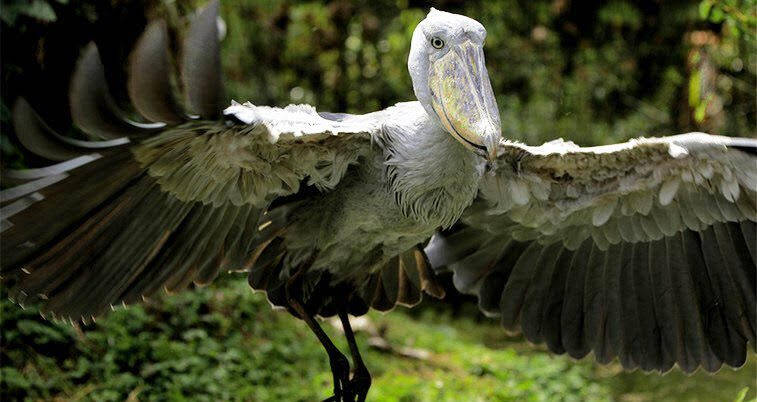

The guide and the tourists move on the water to the areas where the bird is commonly spotted using a canoe. In Uganda, one of the most famous destinations for shoebill birding safaris is Mabamba baylocated on the western side of Entebbe on the shore of lake Victoria. These fascinating birds are found in swampy areas with fresh water characterized with thick papyrus plants, water lilies and other grass common in fresh water swamps. It may therefore not be easy to spot them just anywhere but chances are normally higher when on a Uganda birding safari to specific spots that we recommend. Although shoebills can live for as many years as 45 and above, they are a critically endangered species of birds, there are about 1000 shoebills left in Uganda. The name of the shoebill stork was derived from its shoe-shaped bill which also gives it a large head hence being referred to as a “King whale-head”. Shoebill Uganda – The exclusive shoebill stork is one of the rare to see birds in Africa and is one of the famous birds of Uganda to look out for on your Uganda safari.
#Shoebill sounds how to#
How To Acquire A Gorilla Trekking Permit.Best Time To Go Gorilla Trekking in Uganda.6 Days Gorillas and Murchison Falls Safari.5 Days Gorillas and White water rafting.The majority of that population is concentrated in South Sudan, Uganda, Tanzania, and Zambia. Currently, the IUCN estimates there are between 3,300 and 5,300 adult shoebills left in the wild. In some areas, shoebills are also hunted for food, while in others they are killed because they are seen as bad omens. Habitat destruction and industrial pollution are affecting populations.

Unfortunately, as one might imagine, the shoebill's major predator is us. To fend off predators from stealing eggs, shoebills build their nests in places that are difficult to reach, and they aren't afraid to get aggressive to defend that nest. In the wild, they can live for nearly 36 years and, as one might imagine, adults don't have major predators. Even mating pairs search for food on opposite ends of the territory.

Interestingly, shoebills don't live in groups. But they can also hunt monitor lizards, baby crocodiles, turtles, and frogs. They primarily feast on lungfish, bichirs, catfish, and tilapia. Fish is the main component of their diet. Though shoebills are carnivores, they're looking for small prey. If you were wondering what these prehistoric-looking birds eat, don't worry-humans aren't on the menu. Then, they'll clatter their bills, much like storks do, to communicate with one another. Shoebills are typically silent except when they arrive at the nest. They're not only deliberate in their movements but also in their sounds. This means that they simply fall forward on their prey with their beaks wide open, scooping up their meal. And when the time is right, they make their move by exhibiting a behavior called collapsing. Shoebills can stand motionless for hours, waiting for the perfect moment to catch their prey. Just their clog-like beak, alone, measures a foot long and nearly half a foot wide.īut if you came upon a shoebill, there's a good chance you'd be intimidated not only by the size but the fact that they don't move. They can reach up to five-feet high with an eight-foot wingspan, making them fairly intimidating. Thanks to their stature, they truly are kings of their environment. Their thin legs with large feet give them the ability to wade through the vegetation of swamps and marshes from Ethiopia to Zambia. The shoebill's natural habitat is the swamps of eastern Africa.


 0 kommentar(er)
0 kommentar(er)
